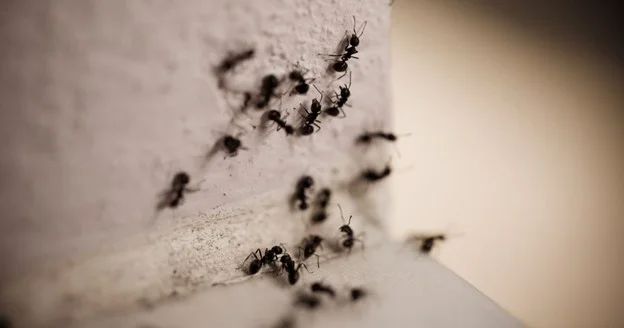When ants invade your space, it can quickly become frustrating. Knowing effective ant exterminator techniques can help you regain control of your home or garden. These methods range from natural remedies to professional extermination services, allowing you to choose the best approach for your needs.
Understanding the specific type of ant you are dealing with is crucial in selecting the right extermination technique. Some methods may work better for certain species, while others may be less effective. Exploring options like baiting systems, insecticidal sprays, and natural deterrents can significantly impact your success in eliminating these pesky intruders.
Implementing the right strategies addresses the immediate problem and prevents future infestations. By being proactive and informed about ant exterminator techniques, you can create an environment that discourages these pests from returning.
Understanding Ant Behavior and Infestation Patterns

Recognizing ant behavior and identifying infestation patterns are crucial for effective pest management. This knowledge allows you to apply targeted extermination techniques for successful control.
Identifying Common Ant Species
Different ant species exhibit distinct behaviors and nesting habits. Common species include:
- Carpenter Ants: These ants tunnel through wood, creating noticeable damage and often nesting in damp areas.
- Sugar Ants: Attracted to sweet substances, they are often found in kitchens, foraging for food.
- Pavement Ants: Typically nesting in soil or under pavement, they can invade homes for food.
Identifying the specific species in your home is vital. It helps determine the most effective ant exterminator techniques and control solutions.
Analyzing Ant Entry Points and Nesting Areas
Ants often enter homes through tiny cracks or gaps. Common entry points include:
- Windows and Doors: Check for small openings or damaged screens.
- Foundations: Inspect around baseboards and foundations for cracks.
- Plumbing: Look around at the pipes and other utilities’ penetrating surfaces.
Nesting areas may be outside or within the home. Search for:
- Moisture Areas: Ants prefer damp environments, so inspect wet basements or areas with leaks.
- Natural Debris: Leaves or mulch near the home’s foundation can provide ideal nesting conditions.
Understanding these patterns aids in implementing measures to prevent infestations effectively.
Professional Ant Extermination Methods
Effective ant extermination requires a combination of strategies tailored to your specific situation. Techniques range from chemical treatments to non-chemical options, allowing professionals to target ant infestations effectively.
Chemical Treatments and Baits
Chemical treatments include insecticides specifically designed to eliminate ants at various life stages. Professionals often use baits that attract ants and contain slow-acting toxins.
- Baiting Systems: These systems involve placing bait stations in strategic locations. Ants carry the bait back to their colonies, affecting the entire population.
- Residual Sprays: These sprays create a barrier that prevents ants from entering your home. To avoid harm to pets and humans, following application instructions is essential.
- Insect Growth Regulators (IGRs): IGRs disrupt the life cycle of ants by preventing them from developing into adults, thus reducing population growth.
Careful placement and choice of chemicals ensure maximum effectiveness. Best practices include avoiding using DIY solutions that may not work as intended.
Non-Chemical Extermination Techniques
Non-chemical methods can be effective, particularly in sensitive environments. You might consider these options as part of a comprehensive strategy:
- Physical Barriers: Sealing entry points with caulk or weather stripping helps prevent ants from accessing your space.
- Boric Acid: This natural insecticide can be mixed with sugar and water to create a sticky trap. It is less harmful and can effectively target ants.
- Diatomaceous Earth: Sprinkling this powder in areas frequented by ants can dehydrate and kill them upon contact.
- Hot Water Treatments: Pouring hot water on ant hills can eradicate colonies, but this needs careful application to avoid damage to your landscape.
These methods often complement chemical treatments, ensuring guaranteed ant removal strategies in Carrollton. Combining approaches maximizes the chance of full extermination while minimizing risk.
Long-Term Ant Control Strategies

Effective long-term control of ant infestations requires proactive strategies that focus on modifying your environment and maintaining vigilance. Implementing these methods can help prevent future infestations and ensure a pest-free living space.
Landscape and Environmental Modifications
You can mitigate ant problems by making specific changes to your landscape. Start by removing food sources such as spilled garbage and pet food. Maintain a clean environment around your home and garden.
Consider these landscaping tips:
- Mulch: Use non-organic mulch or pine needles to deter ants, as they prefer organic materials.
- Plants: Avoid using plants that attract ants, like aphid-driven species.
- Barriers: Install physical barriers, such as gravel or stone, around foundations to limit ant entry.
Seal any cracks or gaps in your home’s exterior as well. These modifications can lead to permanent ant infestation solutions by discouraging their presence.
Regular Maintenance and Monitoring
Continuous monitoring is essential to ensure that your preventative measures remain effective. Regularly inspect your home, especially around entrances and areas prone to moisture.
Implement these maintenance practices:
- Routine Checks: Schedule periodic inspections to catch potential infestations early.
- Pest-Proofing: Ensure that windows and doors are sealed properly.
- Remove Nesting Sites: Keep firewood and debris away from the home’s foundation since these can serve as nesting areas.
You might find that using professional assistance is beneficial. Critter Stop, renowned for high-quality work and exceptional customer service, can help identify and address pest issues.

Karen Altizer is a seasoned professional with a wealth of expertise in marketing and communications, adept at crafting compelling narratives and strategic messages tailored to various stakeholders.

